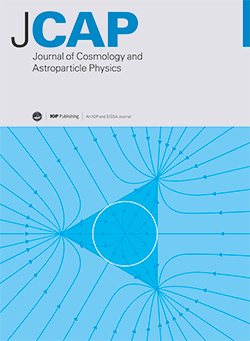Dark sector interactions in light of weak lensing data
IF 5.3
2区 物理与天体物理
Q1 ASTRONOMY & ASTROPHYSICS
Journal of Cosmology and Astroparticle Physics
Pub Date : 2025-06-23
DOI:10.1088/1475-7516/2025/06/046
引用次数: 0
Abstract
The current observational tensions in the standard cosmological model have reinforced the research on dynamical dark energy, in particular on models with non-gravitational interaction between the dark components. Analyses of late-time observables like type Ia supernovas (SNe Ia) and large-scale structures (LSS) are not conclusive about the presence of energy flux between dark energy and dark matter, while the anisotropy spectrum of the cosmic microwave background (CMB) is fully consistent with no interaction at all. As background and visible matter tests are less sensitive to the suppression/enhancement in the dark matter power spectrum, which is a characteristic of interacting models, while the CMB spectrum is strongly affected by it, this could be the origin of those results. In order to confirm it and at the same time to rule out the role of possible systematics between early and late-time observations, the use of a low redshift observable sensitive to the gravitational potential generated by dark matter is crucial. In the present paper, we investigate the observational viability of a class of interacting dark energy models, namely with energy exchange between vacuum-type and dust components, in the light of the Dark Energy Survey (DES) observations of galaxy weak lensing, in the context of a spatially-flat Friedmann-Lemaître-Robertson-Walker spacetime. The best fit of our analysis is entirely consistent with null interaction, confirming the CMB based constraints.弱透镜数据下的暗扇区相互作用
目前标准宇宙学模型中的观测张力加强了对动态暗能量的研究,特别是对暗组分之间非引力相互作用的模型的研究。对Ia型超新星(SNe Ia)和大尺度结构(LSS)等晚时间观测结果的分析并不能确定暗能量和暗物质之间存在能量通量,而宇宙微波背景(CMB)的各向异性谱则完全一致,根本没有相互作用。背景和可见物质测试对暗物质功率谱的抑制/增强不太敏感,这是相互作用模型的一个特征,而CMB频谱受其强烈影响,这可能是这些结果的来源。为了证实这一点,同时排除早期和后期观测之间可能的系统作用,使用对暗物质产生的引力势敏感的低红移观测是至关重要的。在本文中,我们在空间平坦的friedman - lema - robertson - walker时空背景下,根据暗能量调查(DES)对星系弱透镜的观测,研究了一类相互作用暗能量模型的观测可行性,即真空型和尘埃组分之间的能量交换。我们分析的最佳拟合与零相互作用完全一致,证实了基于CMB的约束。
本文章由计算机程序翻译,如有差异,请以英文原文为准。
求助全文
约1分钟内获得全文
求助全文
来源期刊

Journal of Cosmology and Astroparticle Physics
地学天文-天文与天体物理
CiteScore
10.20
自引率
23.40%
发文量
632
审稿时长
1 months
期刊介绍:
Journal of Cosmology and Astroparticle Physics (JCAP) encompasses theoretical, observational and experimental areas as well as computation and simulation. The journal covers the latest developments in the theory of all fundamental interactions and their cosmological implications (e.g. M-theory and cosmology, brane cosmology). JCAP''s coverage also includes topics such as formation, dynamics and clustering of galaxies, pre-galactic star formation, x-ray astronomy, radio astronomy, gravitational lensing, active galactic nuclei, intergalactic and interstellar matter.
 求助内容:
求助内容: 应助结果提醒方式:
应助结果提醒方式:


